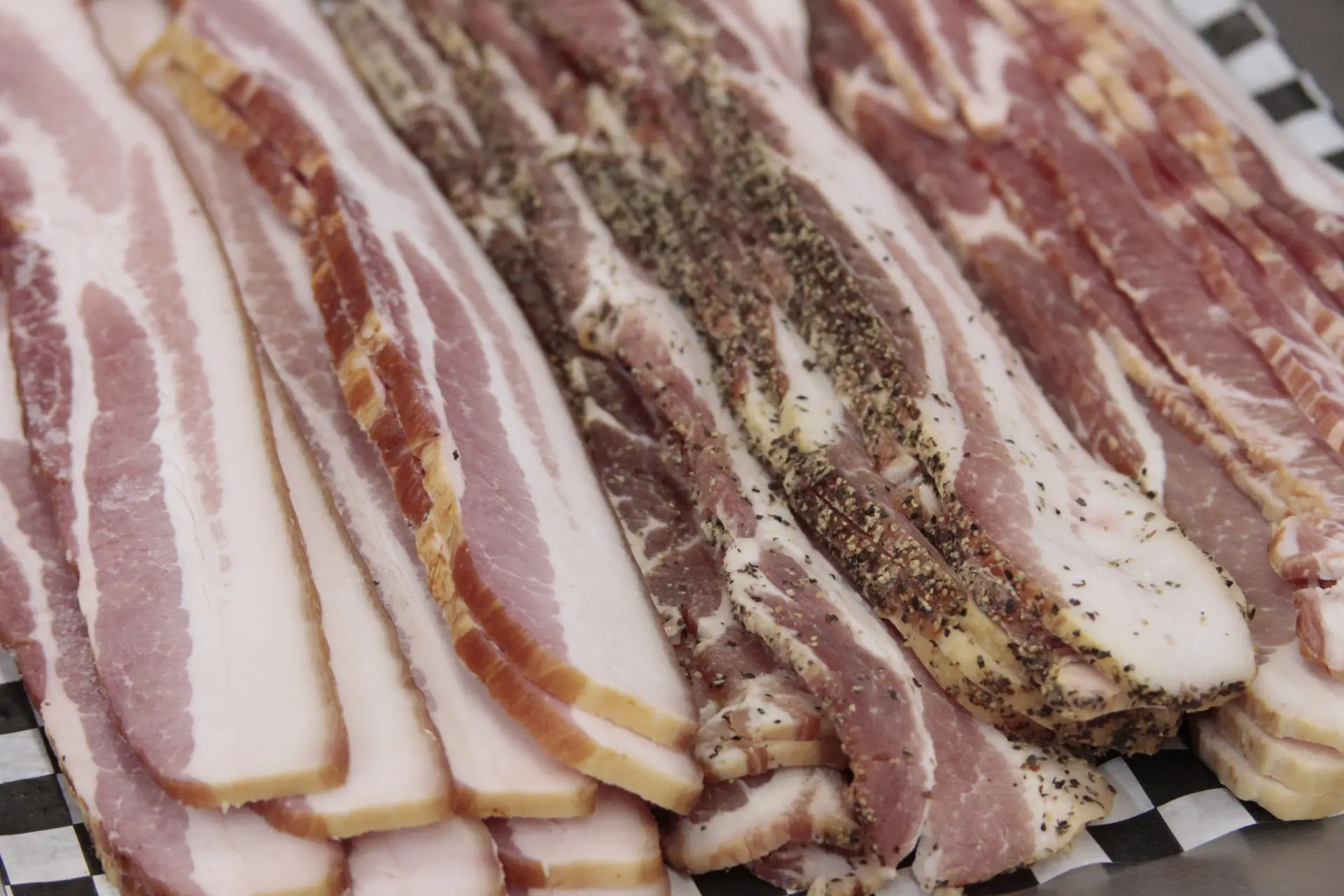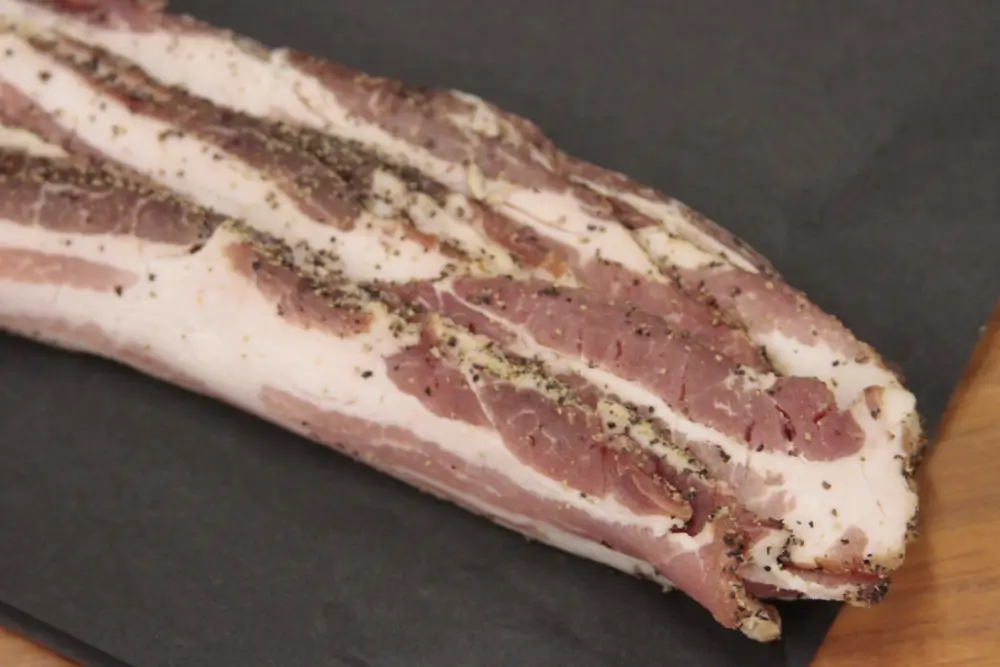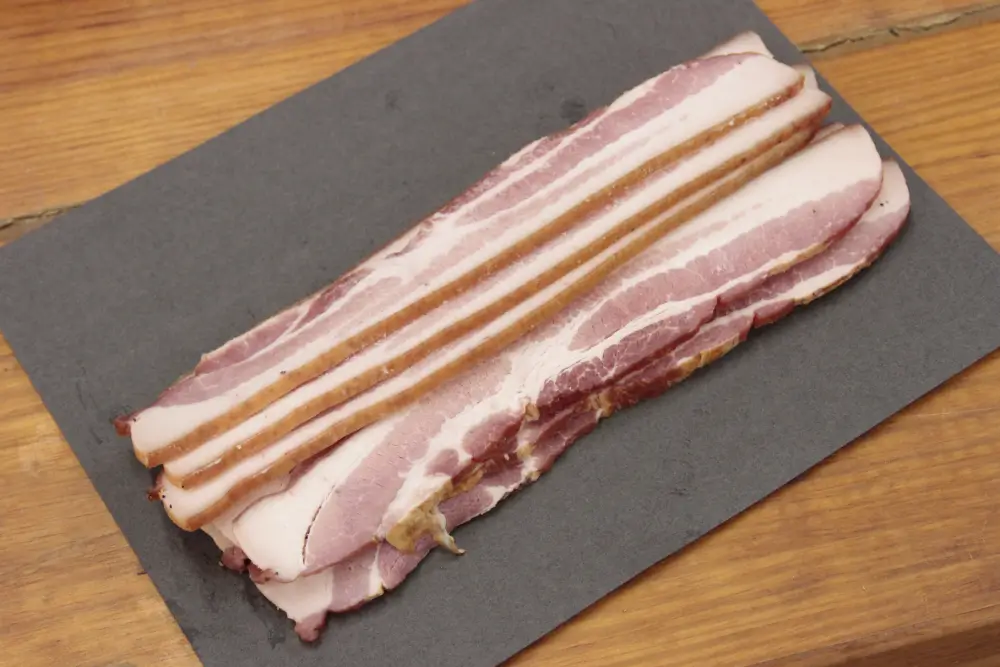Bacon lovers or in other words, everybody, we’ve got a new recipe for you! Bacon is already delicious but this takes it to the next level. We partnered with Powerhaus BBQ to bring you a mouth-watering recipe for homemade spiced bacon, grilled to perfection. Check out the full video tutorial below, where Powerhaus BBQ showcases the process from start to sizzling finish.
Where to Find Your Ingredients
For those in the Augusta area eager to try this recipe, head to Lanier’s Meat Market at 1831 Walton Way to pick up your fresh pork belly. Don’t forget to grab your spices and wood pellets while you’re there!
No time to spare. You can order your meat online: Order Ahead

Choosing Your Bacon
Select thick-cut bacon for grilling. This type not only withstands the grill’s heat
better but also provides a satisfying, meaty texture that’s perfect for BBQ. Look for bacon with a good amount of fat, as this will render slowly on the grill, creating crisp edges and a tender center.
At Lanier’s we sell three main types of bacon with skin, bacon without skin, and peppered bacon. Here are the differences:
Definition and Appearance
- Bacon with Skin: This type of bacon includes the pork skin or rind attached to the slices. The skin is the outermost layer that was originally part of the hog’s belly or back. It appears as a tougher, more leathery layer on one edge of the bacon slice.
- Bacon without Skin: Rindless bacon has the skin removed before slicing. It consists only of the fatty layers and meat, which makes it more uniform in texture and often more visually appealing on the plate.
- Peppered Bacon: The most distinguishing feature of peppered bacon is its appearance. It is generously coated with crushed black pepper, often visible as a speckled, blackened crust that covers the meaty pink and white fatty stripes of the bacon. This gives it a rustic, gourmet look that stands out in any dish.
Texture
- Bacon with Skin: Cooking bacon with the skin on can result in a chewier texture, especially if the skin does not crisp up adequately. Some people enjoy the varied texture, while others might find the skin tough and difficult to chew.
- Bacon without Skin: Rindless bacon typically cooks to a more consistent crispness and tenderness throughout the slice. Without the skin, each piece is easier to bite through and chew, making it a preferred choice for those who enjoy a uniformly crispy bacon.
- Peppered Bacon: typically maintains the classic texture of bacon, which is a delightful balance between crispy edges and chewy, fatty strips. The addition of a pepper crust can add a slight textural contrast, especially if the pepper grains are coarser, providing a crunchy bite in some areas.
Flavor
- Bacon with Skin: The skin can impart a slightly stronger, more robust pork flavor, as it retains some of the flavors from the fat and meat that cook directly against it. However, this might be subtle and more noticeable in artisanal or traditionally cured varieties.
- Bacon without Skin: Without the skin, the flavor of the bacon can be a bit cleaner and more focused on the salted and smoked characteristics of the meat and fat itself. This allows the cure and smoke flavors to shine through more prominently.
- Peppered Bacon: The flavor of peppered bacon is robust and intense. The smokiness of the bacon is complemented by the sharp, piquant kick from the black pepper, which can also add a slight heat that lingers. This combination enhances the umami and salty aspects of the bacon, making it a favorite for those who appreciate a stronger, more dynamic taste profile.

Cooking Process
- Bacon with Skin: Cooking bacon with the skin on requires more attention to ensure that the skin crisps up without the rest of the bacon becoming overly hard or burnt. It may also take slightly longer to cook thoroughly compared to rindless bacon.
- Bacon without Skin: Rindless bacon generally cooks more quickly and evenly. It’s easier to achieve a uniform crispness across the bacon slice, which can be more convenient for both amateur cooks and experienced chefs.
- Peppered Bacon: When grilling, it’s important to manage flare-ups due to the high-fat content and to prevent the pepper from charring too much, which can affect the flavor negatively.
Uses and Preferences
- Bacon with Skin: Bacon with the skin might be preferred in traditional cooking settings or in recipes where a heartier, more rustic presentation and texture are desired. It can also be a preference based on regional or cultural culinary practices.
- Bacon without Skin: This is commonly found in grocery stores and is favored for its ease of use and uniform cooking results. It’s versatile for both simple breakfast plates and in complex dishes where a predictable texture of bacon is necessary.
- Peppered Bacon: Peppered bacon, with its enhanced flavor profile, is a delightful twist on traditional bacon, making it a sought-after ingredient in savory dishes, but it can add an unexpected kick served alongside pancakes and waffles.

Preparing the Grill
- Heat Configuration: Set your grill to medium heat. If using a charcoal grill, allow the coals to burn down to a steady glow with a layer of ash.
- Avoid Flare-ups: Since bacon fat can cause flare-ups, consider using a grill mat or a cast-iron griddle on top of the grates. This setup helps manage the grease and distribute the heat evenly.
Grilling Techniques
- Indirect Heat: To avoid burning, cook the bacon using indirect heat. If your grill has multiple burners, turn off the burner directly under the bacon. On a charcoal grill, position the bacon away from the coals.
- Turning for Perfection: Grill the bacon for about 10-15 minutes, turning every few minutes to ensure even cooking and to prevent it from burning. Keep a close watch as the cooking time may vary based on the thickness of the bacon and the grill’s temperature.
Recipe
Ingredients
- Porkbelly – 3 lbs.
- Blackbeard Spice Co. Kraken – 1 Spoonful
- Blackbeard Spice Co. Calico Jack – 1 Spoonful
- Pink Curing Salt – 1 tsp.
- Bear Mountain: Maple Bourbon Pecan Premium Hardwood Pellets
Equipment
- Ziploc bags
- Refrigerator
- Grill
- Griddle
Steps
- Trim off 3 lbs. of pork belly.
- Remove the skin.
- Mix seasonings and salt in a bowl.
- Cover the pork belly with the spice mix.
- Place the pork belly in Ziploc bags.
- Place the pork belly in the fridge.
- Flip the pork belly every day for 7 to 10 days.
- Rinse the pork belly and pat it dry.
- Place the pork belly in the fridge uncovered for 24 hours.
- Fire up the grill with Bear Mountain: Maple Bourbon Pecan Premium Hardwood Pellets at 180 degrees Fahrenheit to 200 degrees Fahrenheit for 3 hours until the internal hit 150 degrees Fahrenheit.
- Slice the pork belly into bacon strips.
- Cook finished bacon on the griddle.

Dive Into More Flavors
Looking to add some extra flavor to your bacon? Try out these delicious and mouth-watering recipes:
Maple Chipotle: This crispy bacon is the perfect accompaniment to a stack of buttermilk pancakes. Its smoky and spicy flavor is balanced by the delicious sweetness of maple syrup.
Sriracha: If you love spicy food, you’ll definitely want to try this recipe. The combination of spicy sriracha sauce, sweet honey, and nutty sesame oil creates a sticky and savory bacon that’s sure to leave your taste buds tingling.
Brown Sugar and Black Pepper: A southern classic, this recipe offers the perfect combination of sweetness and heat. The brown sugar gives the bacon a delicious caramelized flavor, while the black pepper adds just the right amount of kick.
Place an online order for pick up. Learn more about Lanier’s Meat Market or view all products.

0 Comments